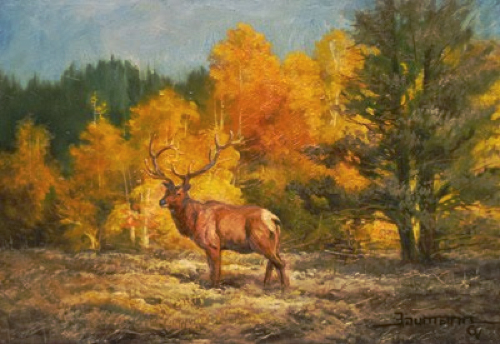“Wapiti Study, Opus 1” by Stefan Baumann
Fall colors of the trees blanketed the hillside with a palette of green, crimson, and amber foliage, signaling the changing seasons. Bursts of air blew through the groves of aspen trees tickling the golden yellow leaves making them quiver. Light breezes started from the foothills and briskly floated upwards to the mountain peaks. In the distance, I could hear the faint whisper of streams of air moving through these beautiful trees. The leaves trembled, making quaking, rustling sounds, and all at once they serenaded me with a grand symphony of song. Millions of leaves let go of the safety of their summer resting spot in the trees high above the forest floor and rained down upon me in a turbulent whirlwind. Millions of leaves fell spontaneously like the confetti at the finale of a political convention, covering the forest floor with a thick carpet of yellow. Against the background of blue spruce, massive Douglas fir, and the white bark pine, these bright leaves shone like golden diamonds on a dark green velvet backdrop. I was aware that I was just an observer of a moment of the symphony of seasons that has existed for thousands of years. In the distance I heard the call of the Wapiti (Elk) echoing throughout the canyon as the males gathered their mates and began their rut.
When I was painting this painting, “Wapiti Study, Opus 1,” I was in a meadow capturing the fall colors when all at once, a massive elk came out of the aspen trees to check out what I was doing. We locked eyes for what seemed like minutes but probably was only several seconds, and after he was satisfied that I was not another bull elk that might be interested in invading his territory he retreated into the woods. When composing a painting in nature, artists imagine and hope to have living creatures included in their composition. Occasionally, an animal will comply and grant a brief but most appreciated opportunity to see and paint them. Artists who are interested in adding wildlife in their paintings spend hours practicing, drawing, and painting studies of animals to use in future compositions. These studies (small renderings in pen and ink, pencil, and paint) become invaluable tools and a vital resource for adding animals to their paintings in the future. I recommend that artists start by drawing people because artists can practice all the techniques needed to draw anything when drawing the human form. Next, practice drawing a dog or cat. Many quadrupeds have similar characteristics to their counterparts in the wild.
“The wonder of the world, the beauty and the power, the shapes of things, their colors, lights, and shades; these I saw. Look ye also while life lasts.” This verse is on a plaque hanging at the Moose Visitor Center at Teton National Park in Wyoming. The original message was etched on a gravestone in Cumberland, England. This humble and unselfish message describes my dreams and efforts at The Grand View, in my art classes and workshops, along with the national PBS television show over the past 25 years. I have devoted my life to touch, move, and inspire others to see and appreciate the beauty of art and its relationship to nature. As we travel through this great land with our 1970 Silver Streak trailer following behind our truck, I passionately desire to share the power and beauty of nature and art with others.
Plein air and Alla Prima artist Stefan Baumann, host of the PBS painting series “The Grand View, America’s National Park through the eyes of an artist” and author of “Observations Of Art and Nature,” travels in his vintage travel trailer painting America’s western landscape. Baumann paints outdoors with oils and canvas capturing stunning vistas, wildlife, western landscapes, National Parks and still life, thrilling art collectors throughout the world. He has many collectors acquiring his paintings as investment internationally. His painting style is called Romantic Realism with Lumunism and the extraordinary way he captures the effect of light is a truly an American Style used to paint the Western Landscape. He can be seen painting in Yellowstone, Yosemite and in the Grand Canyon and Baumann’s “how to paint” DVDs filmed on location in the National Parks are the very best on the market.

